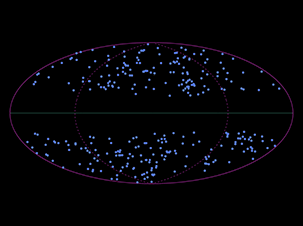A Very Mysterious Direction in the Universe

Konstantinos (Kostas) Migkas
We are pleased to welcome Konstantinos (Kostas) Migkas as a guest blogger. Kostas is a doctoral researcher in the Argelander Institute of Astronomy of the University of Bonn, Germany, and led the study that is the subject of our latest press release. He received his Bachelor's degree in Physics from the Aristotle University of Thessaloniki, Greece, in 2015. Then he moved to Germany and Bonn to obtain his Master's degree in Astrophysics in 2017. He started his PhD by the end of the same year in the group of Prof. Thomas Reiprich working on cosmology with galaxy clusters, exploiting a novel method they designed to study one of the key principles of cosmology.
Our understanding of the Universe has significantly improved in the last 25 years. The accelerating expansion of the Universe, the detailed observation of the leftover relic radiation from the Big Bang (cosmic microwave background, or CMB), the in-depth study of the Universe's structure and the unfolding of the cosmos in the whole range of the electromagnetic spectrum are some of the accomplishments that led astronomers to precisely constrain the so-called cosmological parameters. The latter describe the properties of the Universe in various ways. These include: how much "normal" and "dark" matter the Universe contains, the nature of the mysterious dark energy, and maybe most importantly, the expansion rate of the Universe.
To push cosmological knowledge forward, scientists have to inevitably make some assumptions about the Universe. One of the most fundamental ones is that it acts the same way towards every direction of the sky. Practically, this means that the behavior of the astrophysical objects, for instance galaxies or clusters of galaxies, should look the same no matter where we look. It also means that the cosmological parameters, including the expansion rate of the Universe, must be the same independent of the direction. We call this property "isotropy".
The assumption of isotropy comes as a repercussion of the equations that describe the evolution of the cosmos, which are based on the theory of General Relativity. The main observational evidence for this is the CMB, which is the "picture" of the infant Universe when it had only 0.003% of its current age. The CMB seems to be isotropic, and cosmologists extrapolate this property of the very early Universe to our current epoch, nearly 14 billion years later. However, in about the last 4 billion years the so-called dark energy became the dominant element that drives the evolution of the Universe, constituting 70% of the latter's total content. Its baffling nature has not yet allowed astrophysicists to understand it properly. Therefore, assuming it to be isotropic is almost a leap of faith for now. This highlights the urgent need to investigate if today's Universe is isotropic or not.
There are several studies on this topic up to now, delivering contradictory results. Most use the observations of certain exploding stars (named supernovae), galaxies observed in the radio and infrared regime, quasars, etc. While some results show no significant evidence for deviation from the hypothesis of isotropy, others intriguingly indicate that a particular direction might expand slower than others. However, the confidence with which scientists identify this "anomaly" is not high enough to allow them to make robust conclusions about the isotropy of today's Universe.
For that reason, we need to come up with new, independent and powerful tests that will help us understand if the commonly-used assumption of isotropy still applies today. In 2018, we developed such a method that uses the largest — bound by gravity — objects in the Universe, namely galaxy clusters. As their name reveals, galaxy clusters are groups of tens to thousands of galaxies, with enormous quantities of ionized hot gas — containing atoms stripped of their electrons — between them. This gas emits strong radiation in X-rays and thus we can observe it by telescopes such as Chandra. Analyzing the spectra — the amount of X-rays measured at various energies — of the gas of each cluster, we can find its temperature (millions of Celsius/Fahrenheit degrees) and how bright the cluster is. Astronomers call this its luminosity. While we do not need to make any assumptions to measure the temperature, we do need to know a cluster’s distance to determine its luminosity. To find that, we assume we know the expansion rate of the Universe and that it is the same towards every sky direction.
And here is the catch: there is another way to estimate the luminosity of a galaxy cluster, without any strong cosmological assumptions. It is well known that there is a tight relationship between the temperature and the luminosity of a cluster. First we need to calibrate this relationship using the clusters from the entire sky and assuming the same expansion rate as before.
After that calibration, by measuring a cluster’s temperature we can obtain a good approximation of its luminosity, independent of its directly measured value. If the clusters of one sky region appear brighter or fainter than expected by average, we can evaluate if the expansion rate of the Universe towards this region is faster or slower than the one we assumed initially. Doing so for every direction in the sky, we can see if the expansion rate of the Universe looks the same everywhere. The assumed cosmology to initially calibrate our luminosity-temperature relation has no effect on our conclusions, since we are not looking for the absolute values of the expansion rate. Rather, we are just comparing different sky regions to one another.
In our first study in 2018, we came upon some intriguing results! That's why we decided to look into this more carefully and with more data. To do so, we analyzed 313 galaxy clusters using the Chandra and XMM-Newton telescopes and we combined them with 529 available clusters from previous studies. What we found was even more impressive than our 2018 results. We managed to pinpoint a region that seems to expand slower than the rest of the Universe, and one that seems to expand faster! Interestingly, our results agree with several previous studies that used other methods, with the difference that we identified this "anisotropy" in the sky with a much higher confidence and using objects covering the whole sky more uniformly.
So did we tear down one of the most crucial pillars of cosmology? Not so fast, it is not that simple. At least two scenarios may have led us to wrong conclusions.
Firstly, cosmic material might interfere with the light that travels from the clusters to the Earth. For example, previously unknown gas and dust clouds beyond the Milky Way could obscure a fraction of photons emitted from the clusters. Since we ignore the possible existence of such clouds, we do not account for their interference, and hence we would falsely underestimate the true luminosity of the clusters. Eventually, we could mistake this for a cosmological effect. We performed several tests that led us to believe that this scenario seems unlikely, but not impossible. However, considering that the direction of the anisotropy we find agrees with other studies that used observations in light at different wavelengths, where such obscuring effects are not expected, one could argue against the possibility of such biases in our analysis.
The second case is what we call "bulk flows". In a nutshell, some "superclusters" (groups of galaxy clusters!) exist that attract other clusters towards them through gravity. This can generate a coherent motion of some clusters (lying in the same sky region) towards a supercluster. But why is this important? Well, in our default analysis we assume that these “local” speeds of clusters, on top of the Universe’s expansion speeds, are small and random and that they do not matter in general. If this condition is not met, then our assumption does not hold. This might result in wrong distance (hence luminosity) estimations, producing "fake" cosmological anomalies. This scenario is not far-fetched and more tests are required to deliver a definite conclusion, although such large correlated speeds are not easily expected.
If none of the above is true, then the hypothesis of an isotropic Universe may be under question and a cosmological paradigm shift is possibly required. Of course for such a big change to occur, the astronomical community must perform other scrutinized tests obtaining consistent results every time.
The take-home message is this: the implications of this study could be profound either if a non-isotropic expansion of the Universe exists or if dominant bulk flow motion affects astronomers' measurements. Many studies in cosmology, including X-ray studies of galaxy clusters, assume that the Universe is isotropic and that correlated motions are not significant enough to consider them. Even if the mysterious gas and dust clouds are the origin of our results, the X-ray community might need to revisit their results, if their data were coming from that mysterious sky region.

